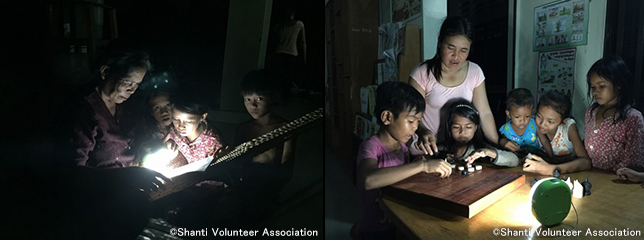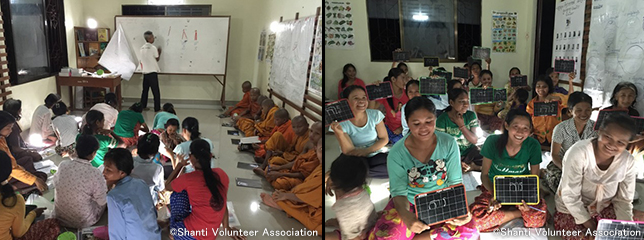2019.07.18Voices
[Voice] Philippines: Lights Providing Support on the Frontlines of Education and Health Care
2015.09.30 Voices
Shanti Volunteer Association, which provides educational assistance by supporting libraries and building schools in six Asian countries, opened community learning centers in Cambodia. Solar lanterns are being used in evening literacy classes set up for adults, many of whom missed the opportunity to learn reading and writing under the Pol Pot regime.
This is Hideki Eguchi from the Cambodia Office of Shanti Volunteer Association (SVA). The solar lanterns donated by Panasonic are being used at evening literacy classes in the Ni Pich commune, in an off-grid area in Kampong Thom Province's Kampong Svay District. Student study eagerly under the bright light.
After the end of its civil war in the latter half of the 1990s, Cambodia achieved rapid economic growth, mainly in urban areas. However, large numbers of academics and educators were massacred during the Pol Pot regime of the late 1970s, robbing people of the chance to receive an education, and leaving many illiterate even as adults today. People who cannot read, write, or do math, lose access to information that is vital in farming or health and hygiene, or they cannot find employment, which keeps them trapped in the cycle of poverty.
The rate of illiteracy is particularly high in rural areas, and the people of Ni Pich commune are no exception. The villagers speak of ongoing challenges, like being forced down in the selling price of rice and livestock because they cannot calculate well, or not being able to read posters and fliers at government offices.
For years, SVA has continued to provide educational support through libraries in rural areas to address these issues. Last year, the organization opened a community library in Ni Pich to provide all of its people, from children to adults, an opportunity to learn.
At this community library, literacy classes for adults are held six times a week. The classes are for two hours, from 6 p.m. to 8 p.m., when people can participate more easily after they've finished their farm work for the day. Many of the students are mothers who bring their children along to class. While they study, someone reads to children at the child-care facility in the library.

While their mothers learn how to read and write, the children join in book reading sessions or enjoy playing board games.
The mothers come to class for many reasons like, "I want be able to read medicine bottle labels and take the right medicine when I get sick," "I want to be able to read signs so that I won't get lost in unfamiliar places," and "I want to be able to read books." Whatever the reason, every mother is thrilled for this chance to finally learn.

The literacy class. This 33-student class consists of women from ages 20-70 and young Buddhist priests.
The solar lanterns are a crucial source of light for these mothers. At the classes and libraries in the evening, the solar lanterns are hung from the ceiling to light the entire space, while at other times, one lantern is placed on a desk for a few people to use. The mothers use their creativity to get the most out of the lanterns, according to the purpose.
The light of the solar lanterns not only lights up the village but it also supports mothers studying at night and empowers them to pave the way for their future.